|
One of the greatest feats of
Victorian exploration took place on 5th
September, 1862 at Stafford Road Gasworks in
Wolverhampton. It consisted of a balloon flight that
greatly increased our knowledge of the atmosphere, and
helped to lead the way to modern weather forecasting.
There were other balloon flights from Wolverhampton’s
gasworks, but this one was very different and far more
important. It was in fact a scientific experiment.
Our ability to accurately forecast
the weather depends to a large extent on our
understanding of clouds, and which types will produce
rain. The ancient Greeks understood that the heat of the
summer evaporated water, which later came down as rain.
This is known as the hydrological cycle. Isaac Newton
greatly improved our knowledge of the cycle, and
calculated how much water is evaporated into the
atmosphere.
In 1803 Luke Howard classified the
different cloud types and gave them Latin names which
were standardised throughout the world.
It’s possible that people’s intense
interest in weather, and rain in particular, was
stimulated by the severe drought in the 1850s, when
everyone was extremely worried about the shortage of
water.
One of the leading scientists of
the day, James Glaisher decided to investigate what
happened to the water vapour as it rose into the
atmosphere. The only way to get there at the time was by
balloon. In the 1860s balloons were mainly used for
entertainment, and ascents were a popular spectacle.
|
|
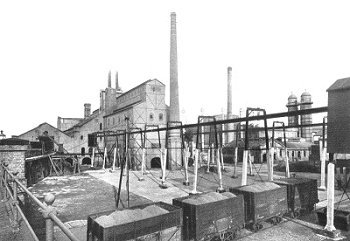
Wolverhampton Gasworks in the
1930s. |
In 1862 the British Association of
Science had selected Wolverhampton Gasworks as a
suitable location for a research balloon flight because
it was sufficiently far inland to prevent the balloon
from being blown out to sea, and the gasworks could
supply the gas to inflate the balloon.
Henry Coxwell was approached for
the flight, and he undertook to build a suitable balloon
at his own cost.
The balloon was 55 feet in
diameter, and 80 feet high, with a capacity of 93,000
cubic feet. |
|
Henry Coxwell was the son of a
naval officer. He saw his first balloon flight at the
age of nine, when he watched Charles Green ascend from
Rochester through a telescope.
At the age of 16 he saw Charles
Green launch a large balloon at Vauxhall.
Coxwell became a dentist, but his
interest in balloons grew. He made his first flight in
1844 at the age of 25, as a passenger in Mr, Hampton’s
balloon which ascended above White Conduit Gardens, at
Pentonville.
He began to make a series of
flights with two rival balloonists, Gale and Gypson,
many of which took place on the Continent.
By 1852 he had become one of the
country’s leading balloonists. |
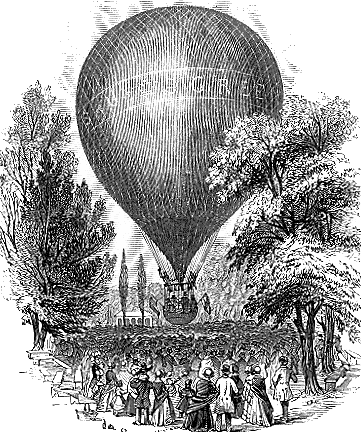
Mr. Green's balloon. From the
Illustrated London News. |
|
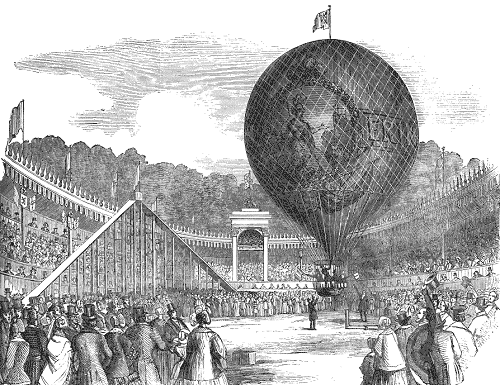
Mr. Hampton's balloon. From the
Illustrated London News. |
Glaisher and Coxwell made a series of balloon
flights to study the moisture content of the air.
Their third and most important flight took place on 5th
September 1862 from Stafford Road Gasworks, where there
was a plentiful supply of town gas for the balloon.
On the day Glaisher filled the balloon basket with 17
scientific instruments and they lifted off at 3 minutes
past one.
During the flight he intended to constantly monitor
the instruments to discover the quantity of moisture
that the air carried at different altitudes. |
|
The balloon rose into the cloud at
5,000 feet, and broke through it onto a plateau of
cloud. Glaisher described it as follows:
On emerging from the cloud at
seventeen minutes past one, we came into a flood of
light, with a beautiful blue sky without a cloud above
us, and a magnificent sea of cloud below, its surface
being varied with endless hills, hillocks, mountain
chains and many snow white masses rising from it. |
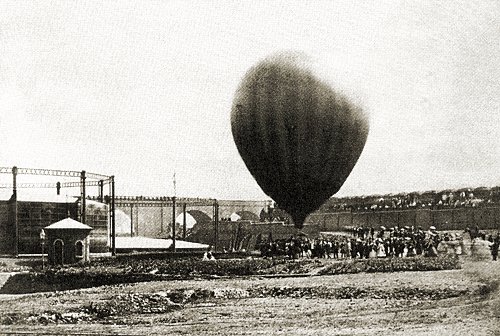
Lift off from the gasworks. |
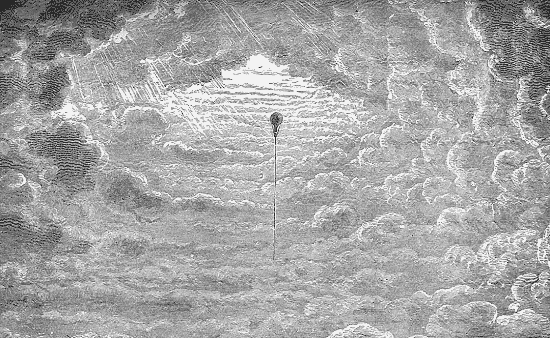
Approaching the cloud.
|
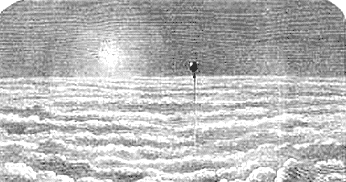
The sea of cloud. From the
Illustrated London News. |
At this point Glaisher attempted,
possibly for the first time ever, to take a cloudscape
photograph. Unfortunately the attempt was unsuccessful.
During the ascent Glaisher took
regular readings of temperature and humidity as the
balloon rose ever higher, but soon things started to go
very wrong.
This was the highest manned balloon
flight that had been attempted, and so the dangers were
not fully understood. |
|
The height of two miles was reached
in 19 minutes, and the temperature was at freezing
point. More sand was discharged, and 28 minutes later
they reached an altitude of 5 miles. Up to this point
Glaisher had no problems reading the instruments but
Coxwell became breathless because of his exertions.
At one point he had to leave the
basket and climb onto the ring to untangle the valve
line, which become entangled because of the rotary
motion of the balloon.
At 29,000 feet Glaisher began to
have problems. He had difficulty seeing clearly and
could not see the column of mercury in the wet bulb
thermometer, or the hands of the watch, or the fine
divisions on any instrument. He soon lost the use of his
arms and legs and fell into unconsciousness.
Coxwell later claimed that he was
so cold and paralysed that his hands ceased to function,
and turned black from lack of oxygen. It seemed that as
the balloon rose even higher, the occupants were doomed
to die. As the air pressure reduced, the envelope would
have expanded until it finally burst, at which point the
balloon would plunge to the ground. |
|
Coxwell claimed that he managed to
grip the balloon’s rip chord in his teeth, and after
three tugs the balloon started to slowly descend. He
then let more gas out, to control the descent. It was an
extremely narrow escape from death.
As the balloon continued its
descent, Coxwell attempted to rouse Glaisher, who soon
regained consciousness and immediately continued to
monitor the instruments and make his observations.
He was a determined scientist who
would stop at nothing to get his results. He had been
unconscious for about 7 minutes.
When Coxwell told him that he had
lost the use of his hands, Glaisher poured brandy over
them. |

| Pulling the rip
chord. From the Illustrated London News. |
|
|
The whole flight took about 2½
hours. Glaisher thought that they had reached an
altitude of 37,000 feet, around 7 miles. A world record
at the time. He found that as they went higher there was
less moisture in the atmosphere. This discovery alone
enhanced out understanding of how and where clouds form,
and advanced our understanding of rain.
The descent, which was at first
very rapid, was effected without difficulty at Cold
Weston. It had been one of the greatest journeys of
Victorian exploration. A prodigious, and scientifically
significant feat. |
 |
Return to
the
previous page |
|